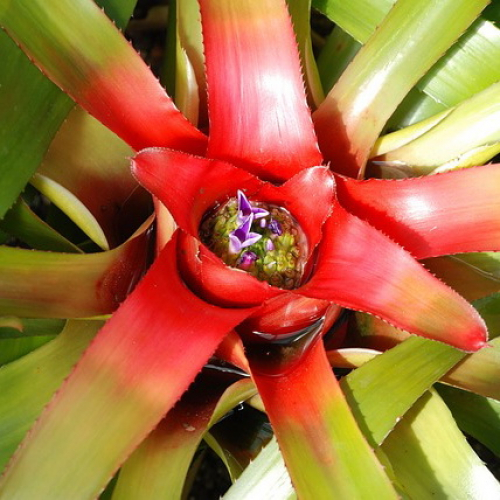Indoor plants Bromelia

Description
Special Features of Bromelia
Bromelia is a genus of the bromeliad family Bromeliaceae. Modern taxonomy classifies about 50 species of terrestrial grasses into this genus. They are characterized by rosettes of rigid leaves around the central tank, bright flowers gathered in heads or panicles, amazing silhouettes, unpretentiousness, and vitality.
Historically, all these species are native to tropical America (this can be the reason why they are jokingly referred to as "temperamental Mexicans"). There, mostly red and pink Bromelias occur. During cultivation and painstaking breeding, the colour range has expanded considerably and now includes white, yellow, orange, purple, and scarlet; there is even bicolour (pink and purple) Bromelia. The diversity progress is clearly endless. For example, at the 16th International Flower Exhibition 2009 in Russia, Dutch growers presented a frost-resistant garden Bromelia that tolerated temperatures up to -20 ° C.
Countless Bromelia subspecies grow well in the garden, adorning it with their blooms until late autumn (if the autumn is warm), or indoors where they bloom throughout the winter, even a long one. When all other plants go dormant, Bromelia pleases eyes with its magnificent beauty, making all your care efforts worthwhile.
You must know that Bromelias bloom only once in their lifetime and die after flowering leaving a small group of offsets.
The family Bromeliaceae includes, in particular, the following genera: Pineapple (Ananas), Billbergia, Vriesea, Hechtia, Guzmania, Dyckia, Cryptanthus, Neoregelia, Nidularium, Tillandsia, Fascicularia bicolour, and Aechmea. Some of these are described in our Garden Encyclopaedia.
The Secrets to Successfully Growing Bromelias
Keep Bromelia in the bright light but avoid direct sunlight!
Watering method for Bromelias seems weird unless we take into account a small root system and large leaves of this plant. Do the following:
- Fill in the central tank with water and do not water the soil.
- The soil must not be soggy or your young plants may die before blossoming. Good drainage is required.
- Do not overwater. Let water dry out from the central tank before the next watering. Water frequently.
- The plant cannot take in water from the soil by roots but quickly takes in water from the air by leaves. That means the air is to be very humid all the time. Mist Bromelia frequently and generously.
High humidity is the first of the two prerequisites to ensure flowering.
The other prerequisite is a high temperature, at least 25 ° C or more.
If the plant is already in bloom, normal temperature will be sufficient (but no less than 12 ° C).
Bromelia likes to be in a very well ventilated room. However, make sure there are no drafts.
Feed Bromelia with liquid fertilizer. You can put it in the mist bottle and mist near the leaf surface.
Repotting is usually rarely required or not required at all.
Bromelia is propagated by offsets (pups) formed at its base. Wait until they are a few months old, carefully remove, pot in the lightweight soil, create warm and humid environment, and keep until full rooting.
The plant does not need pruning. Remove only damaged or dried parts of the leaves. Use sharp scissors to avoid crushing or shredding healthy tissue.
The death of the rosette after flowering is natural and not a sign of disease or pests. The main thing is that the mother plant sends up offsets after blooming. You can remove the mother plant and leave the pups in the same pot. Alternatively, you can pot them individually.
Potential Problems
If the leaf tips turn brown, the reasons are as follows:
- Humidity is not high enough.
- No water in the central tank for too long time.
- The water used for watering and misting is too hard.
Pale brown spots on the leaves are caused by sunburn. Move the pot to another place to avoid direct sunlight. If you want to keep the plant in the south-facing window, make sure to shade it.
Bromelia is prone to scale insects and mealybugs. Sometimes (but very rarely) it can get a fungal disease "powdery mildew". Control by spraying or dusting plants with colloidal sulphur, copper chloride, copper sulphate, or other compounds of divalent copper, zinc, and iron.







 5 350
5 350







